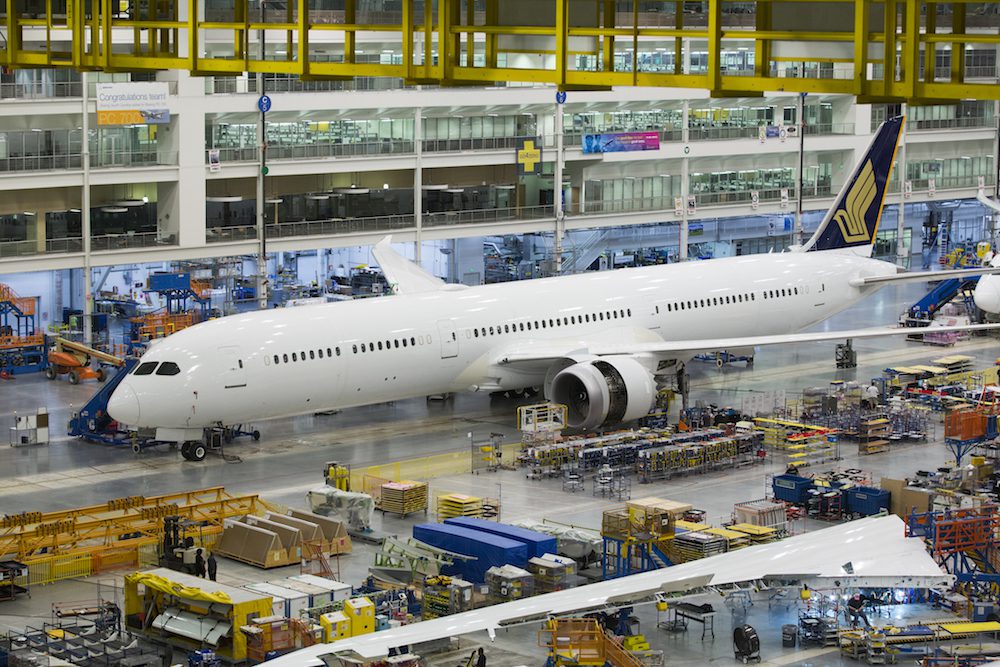
Boeing is awaiting a decision from the FAA that would potentially require modifications to in-service 787s, such as the Singapore Airlines 787-10 pictured here, related to a manufacturing flaw that has temporarily lowered the aircraft type’s production rate and delivery schedule. (Boeing)
Boeing CEO Dave Calhoun told investors Wednesday during the company’s second-quarter earnings call that any decision related to a requirement for in-service 787s to be modified—after a manufacturing flaw was recently discovered on some undelivered Dreamliners—will be left up to the Federal Aviation Administration (FAA).
The second quarter was the first profitable one for Boeing since the beginning of 2020, with sales increasing to $17 billion, up from $11.8 billion during the same period a year ago driven by more commercial aircraft deliveries. Boeing’s commercial airplanes business posted $6 billion in sales, up 268 percent as aircraft deliveries nearly tripled to 79 planes, and a $472 million operating loss versus a $2.8 billion loss a year ago.
On July 13, Boeing temporarily lowered the production rate of the 787 and stopped delivering the aircraft due to small gaps identified in the forward pressure bulkhead. The company’s chief executive answered several analyst questions concerning their progress in resolving the manufacturing flaw.
“That’s a determination that has to be made with the FAA, and most of this in light of the fact that the safety margins on the structural elements of our airplanes is huge. So, it’s not the world’s easiest set of analyses to go through and our teams have taken their shot at it. They go through the FAA in great detail. And so, I don’t really know the answer to that,” Calhoun said, responding to an analyst question about whether a retrofit will be necessary for in-service 787s. “But the ideal for all of us is to just incorporate it into ongoing maintenance schedules of the airlines. So that is that’s our hope and desire and sort of anyway, but I’m going to leave it to the FAA and our ultimate conclusions between those two teams as to just what happens on that front.”
There are 100 total 787s currently in Boeing’s undelivered inventory, according to Calhoun. The company expects to deliver fewer than half of those this year.
“We’re progressing through these inspections and rework, including the additional work we shared earlier this month. We continue to engage in detailed discussions with the FAA on verification methodologies for the 787. And based on our assessment of the time required, we’re reprioritizing production resources for a few weeks to support the inspection and rework,” Calhoun said.
In an emailed statement to Avionics International, the FAA confirmed that it was made aware of a manufacturing quality issue near the nose of certain 787s in Boeing’s undelivered inventory. The agency also says that the issue poses no immediate threat to flight safety, however, it is still determining whether some modifications should be made on 787s that are already in service.
Calhoun also stressed that while Boeing is working with the FAA on verification methodologies for 787 fuselages, the identification of the manufacturing flaw and decision to stop deliveries was internally driven by safety protocols and some of the identified components not meeting the company’s design tolerances.
“This is not the FAA getting tough on Boeing. This is Boeing getting tough on Boeing,” Calhoun said. “How do you do it? Well, you have teams inside our suppliers working on process control development understanding of exactly why that spec is necessary and where it is. And on our side, we start putting disciplines in place that make it clear to those supply chains that we’re not going to keep our line running. If we get one that isn’t right. That’s a little bit of what’s going on here.”
Boeing expects the 787 production rate to gradually return to five per month, with the timing of the rate increase dependent on their progress with production stability and delivering the aircraft still in inventory.